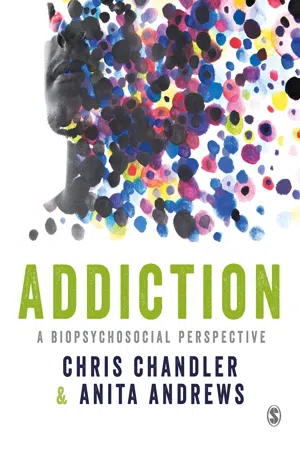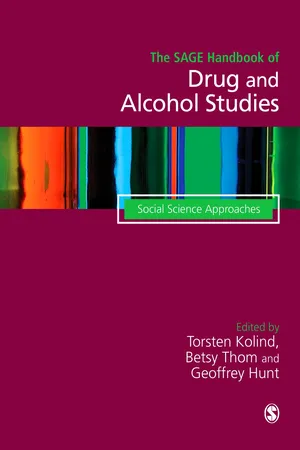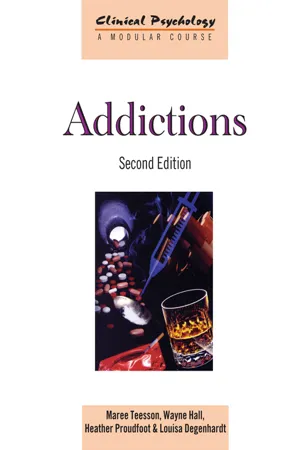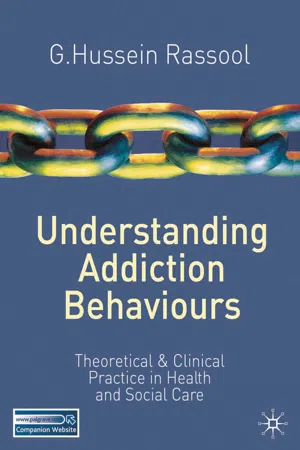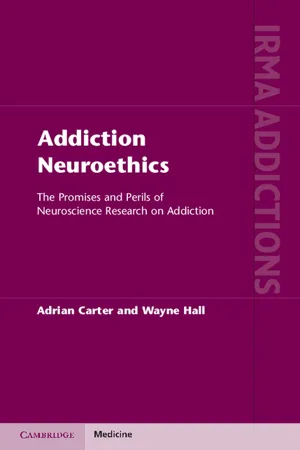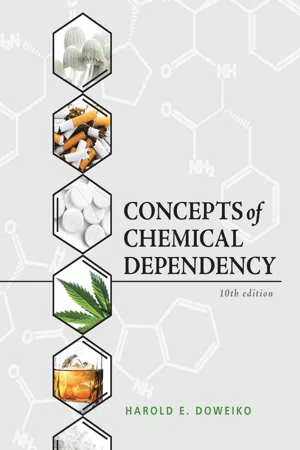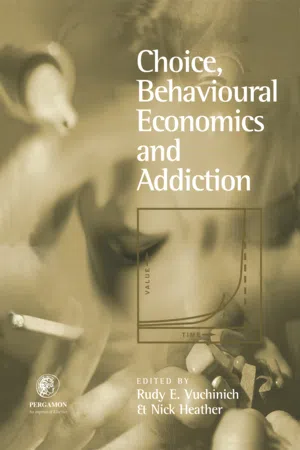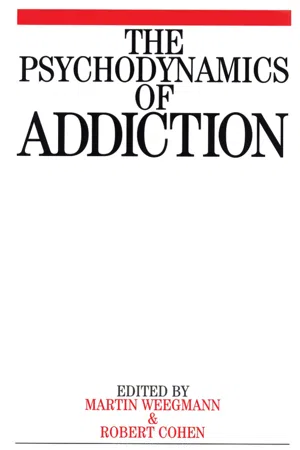Psychology
Theories of addiction
Theories of addiction in psychology encompass various perspectives on the causes and mechanisms of addictive behaviors. These theories include biological models, which focus on genetic and neurological factors, as well as psychological models, which emphasize the role of learning, motivation, and cognitive processes in addiction. Sociocultural theories also consider the influence of social and environmental factors on addictive behaviors.
Written by Perlego with AI-assistance
Related key terms
1 of 5
9 Key excerpts on "Theories of addiction"
- eBook - ePub
Addiction
A biopsychosocial perspective
- Chris Chandler, Anita Andrews(Authors)
- 2018(Publication Date)
- SAGE Publications Ltd(Publisher)
5 Psychological Theories of addictionChapter OverviewThis chapter will describe and evaluate some of the main theories and models which have been used to explain and understand addiction. Different theories and models emphasise different aspects of addictive behaviour to a greater or lesser degree, and offer different levels of explanation ranging from the biological to the societal. All the theories described are of value in contributing to our overall understanding, but no particular theory is able to comprehensively explain and capture all aspects of a condition which is influenced by so many interacting factors.The theories in this chapter have been chosen as illustrative examples of particular approaches, but readers should be aware that there are many other theories, approaches and personal accounts, which attempt to explain and understand the driving forces behind addiction, which are not covered in this chapter.This chapter will:- Outline the disease or biomedical model of addiction, briefly tracing its history through alcohol and opioids to how it is currently conceptualised
- Describe example theories which emphasise the role of choice and the influence of cognitive processes such as attention, perception and memory in driving addictive behaviour
- Outline two example theories which attempt to integrate diverse aspects of addiction into an overarching comprehensive framework
Learning Aims of the Chapter
- To have an awareness of the predominance of the disease model of addiction
- To gain an awareness of the factors which contribute to addictive behaviour and how some of these factors are linked to specific Theories of addiction
- To be aware of the difficulties involved in limiting our understanding of a complex behaviour to any particular theoretical viewpoint
- To have an understanding of how different aspects of addictive behaviour can be integrated into broad theories which seek to synthesise different contributory components of addictive behaviour
Introduction
A comprehensive theory of addiction should be able to account for the key features of addiction including: individual susceptibility; its development and maintenance; how it is experienced physically and psychologically (features such as tolerance, craving, impulsive and compulsive use); and be able to suggest possibilities for treatment. Ideally a good theory should generate testable hypotheses. This is extremely challenging because it is very difficult to design studies in this field which accurately represent experiences in the real world (ecologically valid experiments). This is because in addition to societal and cultural impacts, addiction is experienced on an individual level, as a personal conflict, in individually triggering and personal environments. As a result of this complexity, most Theories of addiction help us to understand one part of the picture more clearly without necessarily adequately addressing the other parts. - eBook - ePub
The SAGE Handbook of Drug & Alcohol Studies
Social Science Approaches
- Torsten Kolind, Betsy Thom, Geoffrey Hunt, Torsten Kolind, Betsy Thom, Geoffrey Hunt, Author(Authors)
- 2016(Publication Date)
- SAGE Publications Ltd(Publisher)
Psychological formulations of addiction typically view the behaviour as serving some function for the individual, for instance, a desire for social belonging, euphoria or relief from negative emotions. Behaviourist theories focus on external contingencies driving forward addiction, whereas others focus more on individual vulnerabilities such as mental health, inadequate coping skills or cognitive deficits; still others, such as psychodynamic theories, focus more on universal but distorted unconscious developmental patterns. Inconsistencies between goals, thoughts, feelings and behaviours, also raises intriguing questions about the interplay of conscious, controlled responses, sometimes referred to as ‘explicit social cognition’, and non-volitional drives that are unconscious, automatic responses or so called ‘implicit social cognition’.Our current understanding of addiction tends to adopt elements from a number of theories and in this chapter we focus on: (i) psychodynamic thinking; (ii) behavioural theory; (iii) social learning theory; (iv) cognitive theory; (v) dual process perspectives; (vi) the role of personality and mental health; and (vii) neurobiological and neuropsychological markers. We then introduce addiction-specific models that integrate psychological thinking into an overall framework centred around: (i) motivation; (ii) excessive appetites; and (iii) relapse prevention.Psychodynamic Theories of addiction
Psychodynamic theories provided one of the earliest ways of thinking about addiction. Different schools of psychoanalytic thinking have different theories as to how the personality is shaped, psychopathology develops and change takes place. However, they all share a common belief that our current feelings, thoughts and experiences are affected by our early life experiences and that some of our mental activity is unconscious. Addiction is thought to relate to early experiences of deprivation or over-indulgence, which results in unmet attachment needs, disturbances in the sense of self and difficulties with drive and affect, self-care, dependency and need satisfaction. - eBook - ePub
- Maree Teesson, Wayne Hall, Heather Proudfoot, Louisa Degenhardt(Authors)
- 2013(Publication Date)
- Psychology Press(Publisher)
Theories of addiction:Causes andmaintenance ofaddiction 4Overview: Theories of addiction
In attempting to explain why people become dependent on drugs, theories tend to emphasize either psychobiological or psychosocial approaches. Psychobiological approaches include both neurobiological and genetic explanations of addictive behaviour. Psychosocial approaches focus on explanations that involve learning models and individual differences, usually while taking into account the cultural and environmental factors that make drug dependence more likely. There are a variety of theories regarding the question of why people become dependent on drugs, and it is likely that these are not mutually exclusive. It is clear that we need an approach that synthesizes these perspectives to have the greatest explanatory value (West, 2006).Physiological bases of addiction
Neuroscientific theories
Neuroscience with the aid of neuroimaging is gradually revealing how the brain changes as a consequence of the regular use of drugs. These changes suggest that chronic drug use produces persistent impairments in neurocognitive and motivational states (Carter, Capps, & Hall, 2009).Neuroscientific theories require an understanding of the effects of drugs on the brain. Box 4.1 outlines the actions of each of the major drug classes. Different drugs have different primary actions on the brain, but two major pathways – the dopamine reward system and the endogenous opioid system – have been implicated as being common to the effects of most drugs of dependence (Koob & Le Moal, 2008; Nutt, Robbins, Stimson, Ince, & Jackson, 2007).Dopamine reward system
Neuroimaging has identified the multiple brain systems that are affected by psychoactive drug use. It is hypothesized that changes in these systems may explain the behaviour of drug-addicted people, specifically, their loss of control and compulsive drug taking, and their difficulty in sustaining abstinence and avoiding relapse to drug use. The dopaminergic pathway has dense connections to the fore-brain and the higher cognitive centres of the frontal cortex. Although it is not the only neural system in the brain affected by drug abuse, changes in these pathways are considered to be central to the development and maintenance of addictive behaviour (Carter et al., 2009). - eBook - ePub
Addictions Counseling Today
Substances and Addictive Behaviors
- Kevin G. Alderson(Author)
- 2019(Publication Date)
- SAGE Publications, Inc(Publisher)
Our theoretical stance should also be what informs our practice. The most defensible interventions will always be those that are empirically validated (also called empirically supported or evidence-based) and those that fit within a theoretical orientation. If you believe our thoughts are what primarily determine our feelings and guide our actions, for example, your theoretical orientation is cognitive-behavioral. That does not mean that you view every client through a cognitive-behavioral lens or that you only offer cognitive-behavioral therapy. However, it does mean that, much of the time, this is the theory you are most likely to adopt and use for treatment planning.Smith (2015) wrote that “the addictive process is complex” (p. 14) and that it includes several causative factors such as biological, environmental, and psychological components. That is his theory, and not everyone in the field would agree with him. Nonetheless, he asked some important questions:- Why is one individual able to drink in moderation, whereas another needs to remain abstinent?
- Why are addictions intergenerational in nature but only with certain members of a family?
- To what degree does the specific substance or behavior play a role in determining whether one will become addicted? (p. 1)
Although Maté (2008) strongly argued that “addiction always originates in pain” (p. 34), this overgeneralization does not stand up to scrutiny. Although some addicted individuals do use substances or addictive behaviors to self-medicate, we know that addiction develops from many different trajectories, only two of which result from physical or psychological pain (West & Brown, 2013). Some drugs are inherently highly addictive, such as heroin, methadone, and nicotine (West & Brown, 2013). Additionally, some addicted individuals come from healthy households, but, because of their impulsivity and high risk-taking attitudes, they begin using a drug that enhances their experience with others (e.g., at parties, nightclubs) and continue doing so even when it leads to negative consequences such as addiction.Anytime one makes a global claim in psychology (e.g., “all people do this or that”), the statement is overgeneralized. For example, we could state that no addicted individuals begin using alcohol or a drug wanting to become addicted, but, once an exception is found, the entire statement loses credibility. As West and Brown (2013) stated, there is often no intention to make a substance or behavior into “a regular thing” (p. 33). The key phrase that keeps their statement believable is that there is “often no intention.” Students interested in reading about the plethora of theories applied to addiction are referred to three books: (a) Pagliaro and Pagliaro’s (2019) Theories of addiction: Why People Use Drugs and Substances of Abuse, (b) Kopetz and Lejuez’s (2016) Addictions: A Social Psychological Perspective, and (c) West and Brown’s (2013) Theory of Addiction - eBook - PDF
Understanding Addiction Behaviours
Theoretical and Clinical Practice in Health and Social Care
- G.Hussein Rassool(Author)
- 2011(Publication Date)
- Bloomsbury Academic(Publisher)
The disease theory of addiction maintains that addiction is a disease due to either the impairment of behavioural and/or neurochemical processes. The genetic theory of addiction puts forward a genetic predisposition to alcohol or drug addiction. In social learning theory, in order to understand the effects of alcohol or drugs, cognitive processes must be considered in relation to other factors. In the bio-psychosocial theory, genetic inheritance, physiological differences, family, community, peer or social pressure are all considered. • • • • • • • • • • • • • Reflective activity 3.1 List the Theories of addiction. Describe briefly two Theories of addiction. Why do people use addictive substances? Why do they continue with their addictive behaviours? Describe the patterns of substance use and misuse? Are these patterns applicable to non-pharmacological addictions? What is meant by ‘binge’ drinking? What are the routes of administration of psychoactive substances? • • • • • • • • Perspectives on Addiction 43 References Adiran, M. (2003) ‘How Can Sociological Theory Help Our Understanding of Addictions?’ Substance Use and Misuse 38, 10, 1385–1423. Alcohol Concern (2007) Binge Drinking Factsheet Summary (London: Alcohol Concern). Bierut, L.J., Dinwiddie, S.H., Begleiter, H., Crowe, R.R., Hesselbrock, V., Nurnberger, J.I., Porjesz, B., Schuckit, M.A. and Reich T. (1998) ‘Familial Transmission of Substance Dependence: Alcohol, Marijuana, Cocaine, and Habitual Smok-ing. A Report from the Collaborative Study on the Genetics of Alcoholism’, Archives of General Psychiatry , 55, 11, 982–88. Di Chiara, G. (1995) ‘The Role of Dopamine in Drug Abuse Viewed from the Per-spective of its Role in Motivation’, Drug and Alcohol Dependence , 38, 2, 95–137. Drugscope (2010) Media Guide Glossary – Chaotic use. http://www.drugscope. org.uk/resources/mediaguide/glossary, date accessed 10 January 2010. Drummond D.C., Tiffany, S., Glautier, S. and Remington, B. - eBook - PDF
Addiction Neuroethics
The Promises and Perils of Neuroscience Research on Addiction
- Adrian Carter, Wayne Hall(Authors)
- 2011(Publication Date)
- Cambridge University Press(Publisher)
We begin with a brief review of common or folk understandings of addiction, and the clinical accounts of addictive behaviour that have informed these common-sense views. We then examine the impact that drug use and addic- tion has upon society and the way in which societies have typically responded to it. We conclude by analysing the two dominant models that have been used 19 to explain addiction, the medical and moral, and discuss the relevance of neuroscience research to these models. 2.2. The phenomenology of addiction Addiction is a complex and highly heterogeneous condition that encompasses an array of problematic behaviours that evolve over time in different individ- uals in different ways. This can make defining addiction difficult. It is reflected in the terminology used to describe addictive patterns of drug use, namely, ‘addiction’, ‘dependence’ or ‘substance use disorder’. Addiction is often contrasted with dependence. An individual may be physically or psychologically dependent on a drug or both. People can become physically dependent on a substance without being addicted. Physical dependence involves the compen- satory physiological changes that result from the repeated use of a drug, with the result that rebound aversive symptoms often occur when drug use is abruptly stopped. This is often called a withdrawal syndrome. Some drugs may also produce a discontinuation syndrome that occurs upon abrupt cessation of use, such as the selective serotonin reuptake inhibitors (SSRIs), without producing the drug-seeking behaviour that is characteristic of addiction (Nutt, 2003). Psychological dependence encompasses the variety of psychological changes that drive drug use or makes one feel that they need to use drugs. - eBook - PDF
- Harold Doweiko(Author)
- 2018(Publication Date)
- Cengage Learning EMEA(Publisher)
Ad-mittedly, many people continue to abuse chemicals in spite of social prohibitions, legal sanctions, and the discomfort of drug withdrawal. However, researchers have attempted to understand whether the perceived benefits outweigh the consequences of these behaviors from the perspective of the person misusing substances . This raises the issue of individual choice in the behavioral psychology paradigm of the addic-tions, a confounding factor that must be integrated into a perspective that has contributed much to our understanding of addictive behavior. Challenges to the Learning Theories of the SUDs There has been little criticism of the learning theories, possibly because these theories do appear to account for many of the phenomena demonstrated by persons with substance use disorders. Also, learning systems theories overlap with the behavioral psychology and cognitive behavioral psychol-ogy paradigms, for example, which are reviewed elsewhere in this chapter. Reactions Against the Coping Skills Theories There has been remarkably little criticism of the coping skills theories, possibly because they are rather eclectic and are drawn from a wide range of other theoretical models. III. The Social Component of the Bio/Psycho/Social Model Definition Substance misuse does not take place in a vacuum: In con-trast to the biological and psychological components of the bio/psycho/social model, this perspective attempts to iden-tify and address those social forces that contribute to the individual’s increased vulnerability to the substance use dis-orders and increase his or her compliance with prescribed medications (Batman & Miles, 2015). Overlap with the Biological Model The development of the brain is not guided just by the ge-netic potential of the individual. Rather, the human brain is also a social organ that, from the first days after birth, begins to absorb and respond to the rules of social interaction. - eBook - PDF
- Nick Heather, Rudy E. Vuchinich(Authors)
- 2003(Publication Date)
- Pergamon(Publisher)
Environmental factors thus determine who (and how many) will develop an addiction. For instance, in relation to alcohol, it is well documented that the availability of the substance has an impact on aggregate consumption, as well as on the prevalence of heavy consumption and problem rates (Edwards et al. 1994). Secondly, drug taking behaviour is typically conformist behaviour: The likelihood that any given individual will engage in this sort of behaviour and the extent to which he is doing so very much depends on what other individuals are doing.^ Hence, a theory of addiction should not restrict itself to the agent's level of socializing, as Rachlin's theory does; it also need to take into consideration who the agent is socializing with, and in particular the drug-taking habits of these individuals. Just as loneliness under certain circumstances may foster addiction, so may strong integration into a heavy consuming sub-culture. Notes 1. This is not a reductionistic thesis, since I do not claim that we could replace all mentalistic concepts, such as values, preferences, feelings, motivations and intentions, with a purely physicalistic terminology. 2. Edwards et al. (1982) prefer the term neuro-adaption instead of physical dependence. 3. A realistic version of simultaneous inconsistency could be the following. The agent has good and noble reasons for abstaining, but stronger and less noble (in his own hierarchy) reasons for indulging. He may feel that indulgence is morally wrong, say by inflicting harm on significant others, and he may wish that he did not have the appetite (a secondary preference for abstention), but still he gives in to his lower, selfish motives. 4. Certain allergies offer an example: the clinician needs to provoke the patient's body in order to reach a definitive diagnosis. - eBook - PDF
- Martin Weegmann, Marcel Cohen(Authors)
- 2008(Publication Date)
- Wiley(Publisher)
24 The Psychodynamics of Addiction Torn Tom has been describing tbe diflculty be has in staying oflalcobol for more than short pertods. Tom: I don’t know wbat it is. I know tbat I’vegot to stop drinking, and I want to stop because of all tbeproblems it always causes ... I know I can’t carry on, but tben Iget sort of scared ... andidon‘t know i f I can do ft. Therapist: Perisb the tbougbt of lye without alcobol, eb, Tom? (Tom remains silent, some otber group members smile, tbe discussion moves on to apparently unrelated mutters.) In a subsequent supervision session the tberapist was able to explore bis bostile reaction towards Tom, wbom be bad experienced as ‘wbinging about the loss of a drug’ while be (tbe tberapist) bad been required to cope witb important (and unsatisfactoriIyunresolved) bereavement. 3. Besetting Zinberg regarded the setting as comprising the most important element in the Tripartite Model in its contribution to the aetiology of compulsive drug use. It has been the emphasis on the quality of interactions within the setting that has informed the development of contemporary treatment modes such as motivational enhancement therapy, relapse prevention therapy and others which draw heavily upon the principles of social learning theory. Central to Bowlby’s work on attachment theory is the view that the need for relationships with others is driven by innate need and that it is the vicissitudes of experiences in and of the relationship which will determine the pathway through which such needs will be expressed in the future. Many addicts are likely to present with histories of apparently disordered relationships. It is often the case that the social network will be composed of others with similar drug-taking habits and the prospect of recovery may often confront the addicts with the realisation that social networks are contingent upon continued drug use and also that recovery will necessitate alterations in lifestyle, acquaintances, etc.
Index pages curate the most relevant extracts from our library of academic textbooks. They’ve been created using an in-house natural language model (NLM), each adding context and meaning to key research topics.
